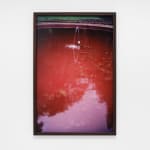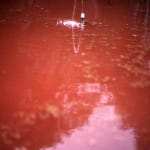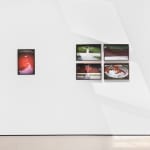Katie van Scherpenberg Brazilian, b. 1940
Jardim Vermelho [Red Garden], 1986/2023
C-Type print
Unframed: 50 x 33 cm (19 3/4 x 13 in)
Framed: 51.5 x 34.5 cm (20 1/4 x 13 5/8 in)
Framed: 51.5 x 34.5 cm (20 1/4 x 13 5/8 in)
Edition 1 of 3 + 2 APs
Further images
Van Scherpenberg's interventions are an extension of her painting practice. In 1968 she moved to live with her father in Amapá, on the remote island of Santana on the Amazon...
Van Scherpenberg's interventions are an extension of her painting practice. In 1968 she moved to live with her father in Amapá, on the remote island of Santana on the Amazon River. This time was to have a marked influence on her artistic practice in the subsequent decades. As curator Alberto Saraiva notes, 'she lacked paint on this island and…researched local soils and anilines for her drawings and paintings,' establishing a direct relationship between artistic matter and environment.
Jardim Vermelho (Red Garden) constitutes a critical moment in the artist’s career, the intimacy between painting and landscape played out on a vast scale. This 1986 intervention saw the artist entirely cover the garden of Parque Lage, Rio de Janeiro’s picturesque art school, in red iron oxide, alluding to her memory of the mud left by the Amazon River on the banks after the pororoca (tidal bore). As the weeks passed in the garden, the vegetation outgrew the pigment and the garden was restored to its original state. Van Scherpenberg's awareness of the passing of time is central to this intervention, her painting transmuted from static object to durational act. The pigment, natural and non-toxic, is reabsorbed into the earth; its steady disappearance is a vital part of the work.
Jardim Vermelho (Red Garden) constitutes a critical moment in the artist’s career, the intimacy between painting and landscape played out on a vast scale. This 1986 intervention saw the artist entirely cover the garden of Parque Lage, Rio de Janeiro’s picturesque art school, in red iron oxide, alluding to her memory of the mud left by the Amazon River on the banks after the pororoca (tidal bore). As the weeks passed in the garden, the vegetation outgrew the pigment and the garden was restored to its original state. Van Scherpenberg's awareness of the passing of time is central to this intervention, her painting transmuted from static object to durational act. The pigment, natural and non-toxic, is reabsorbed into the earth; its steady disappearance is a vital part of the work.
Provenance
Artist's studio; Rio de Janeiro1
of
12
![Katie van Scherpenberg, Jardim Vermelho [Red Garden], 1986/2023](https://artlogic-res.cloudinary.com/w_1600,h_1600,c_limit,f_auto,fl_lossy,q_auto/artlogicstorage/cbprojects/images/view/35a92ecef239fcaa33a97955191407e6j.jpg)
![Katie van Scherpenberg, Jardim Vermelho [Red Garden], 1986/2023](https://artlogic-res.cloudinary.com/w_1600,h_1600,c_limit,f_auto,fl_lossy,q_auto/artlogicstorage/cbprojects/images/view/0d70adc44492413bd3d1db2bbe018a22j.jpg)
![Katie van Scherpenberg, Jardim Vermelho [Red Garden], 1986/2023](https://artlogic-res.cloudinary.com/w_1600,h_1600,c_limit,f_auto,fl_lossy,q_auto/artlogicstorage/cbprojects/images/view/d24da0ac074f6c48e994233d2220b833j.jpg)


